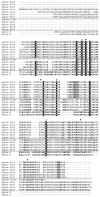A mosquito 2-Cys peroxiredoxin protects against nitrosative and oxidative stresses associated with malaria parasite infection
- PMID: 16540402
- PMCID: PMC2592686
- DOI: 10.1016/j.freeradbiomed.2005.10.059
A mosquito 2-Cys peroxiredoxin protects against nitrosative and oxidative stresses associated with malaria parasite infection
Abstract
Malaria parasite infection in anopheline mosquitoes induces nitrosative and oxidative stresses that limit parasite development, but also damage mosquito tissues in proximity to the response. Based on these observations, we proposed that cellular defenses in the mosquito may be induced to minimize self-damage. Specifically, we hypothesized that peroxiredoxins (Prxs), enzymes known to detoxify reactive oxygen species (ROS) and reactive nitrogen oxide species (RNOS), protect mosquito cells. We identified an Anopheles stephensi 2-Cys Prx ortholog of Drosophila melanogaster Prx-4783, which protects fly cells against oxidative stresses. To assess function, AsPrx-4783 was overexpressed in D. melanogaster S2 and in A. stephensi (MSQ43) cells and silenced in MSQ43 cells with RNA interference before treatment with various ROS and RNOS. Our data revealed that AsPrx-4783 and DmPrx-4783 differ in host cell protection and that AsPrx-4783 protects A. stephensi cells against stresses that are relevant to malaria parasite infection in vivo, namely nitric oxide (NO), hydrogen peroxide, nitroxyl, and peroxynitrite. Further, AsPrx-4783 expression is induced in the mosquito midgut by parasite infection at times associated with peak nitrosative and oxidative stresses. Hence, whereas the NO-mediated defense response is toxic to both host and parasite, AsPrx-4783 may shift the balance in favor of the mosquito.
Figures








Similar articles
-
Nitric oxide metabolites induced in Anopheles stephensi control malaria parasite infection.Free Radic Biol Med. 2007 Jan 1;42(1):132-42. doi: 10.1016/j.freeradbiomed.2006.10.037. Epub 2006 Oct 17. Free Radic Biol Med. 2007. PMID: 17157200 Free PMC article.
-
Peroxiredoxin 1 plays a primary role in protecting pancreatic β-cells from hydrogen peroxide and peroxynitrite.Am J Physiol Regul Integr Comp Physiol. 2020 May 1;318(5):R1004-R1013. doi: 10.1152/ajpregu.00011.2020. Epub 2020 Apr 15. Am J Physiol Regul Integr Comp Physiol. 2020. PMID: 32292063 Free PMC article.
-
Expression of cytosolic peroxiredoxins in Plasmodium berghei ookinetes is regulated by environmental factors in the mosquito bloodmeal.PLoS Pathog. 2013 Jan;9(1):e1003136. doi: 10.1371/journal.ppat.1003136. Epub 2013 Jan 31. PLoS Pathog. 2013. PMID: 23382676 Free PMC article.
-
Cross-talk between nitric oxide and transforming growth factor-beta1 in malaria.Curr Mol Med. 2004 Nov;4(7):787-97. doi: 10.2174/1566524043359999. Curr Mol Med. 2004. PMID: 15579025 Free PMC article. Review.
-
Midgut Mitochondrial Function as a Gatekeeper for Malaria Parasite Infection and Development in the Mosquito Host.Front Cell Infect Microbiol. 2020 Dec 11;10:593159. doi: 10.3389/fcimb.2020.593159. eCollection 2020. Front Cell Infect Microbiol. 2020. PMID: 33363053 Free PMC article. Review.
Cited by
-
Sugar restriction and blood ingestion shape divergent immune defense trajectories in the mosquito Aedes aegypti.Sci Rep. 2023 Jul 31;13(1):12368. doi: 10.1038/s41598-023-39067-9. Sci Rep. 2023. PMID: 37524824 Free PMC article.
-
Nitric oxide metabolites induced in Anopheles stephensi control malaria parasite infection.Free Radic Biol Med. 2007 Jan 1;42(1):132-42. doi: 10.1016/j.freeradbiomed.2006.10.037. Epub 2006 Oct 17. Free Radic Biol Med. 2007. PMID: 17157200 Free PMC article.
-
Heme-Peroxidase 2, a Peroxinectin-Like Gene, Regulates Bacterial Homeostasis in Anopheles stephensi Midgut.Front Physiol. 2020 Sep 8;11:572340. doi: 10.3389/fphys.2020.572340. eCollection 2020. Front Physiol. 2020. PMID: 33013485 Free PMC article.
-
Proteome of the Triatomine Digestive Tract: From Catalytic to Immune Pathways; Focusing on Annexin Expression.Front Mol Biosci. 2020 Dec 9;7:589435. doi: 10.3389/fmolb.2020.589435. eCollection 2020. Front Mol Biosci. 2020. PMID: 33363206 Free PMC article.
-
Non-immune Traits Triggered by Blood Intake Impact Vectorial Competence.Front Physiol. 2021 Mar 2;12:638033. doi: 10.3389/fphys.2021.638033. eCollection 2021. Front Physiol. 2021. PMID: 33737885 Free PMC article. Review.
References
-
- Fang FC, editor. Nitric oxide and infection. Kluwer Academic/Plenum; New York: 1999.
-
- Bryk R, Griffin P, Nathan C. Peroxynitrite reductase activity of bacterial peroxiredoxins. Nature. 2000;407:211–215. - PubMed
-
- Chen L, Xie QW, Nathan C. Alkyl hydroperoxide reductase subunit C (AhpC) protects bacterial and human cells against reactive nitrogen intermediates. Mol Cell. 1998;1:795–805. - PubMed
-
- Wong CM, Zhou Y, Ng RW, Kung HF, Jin DY. Cooperation of yeast peroxiredoxins Tsa1p and Tsa2p in the cellular defense against oxidative and nitrosative stress. J Biol Chem. 2002;277:5385–5394. - PubMed
-
- Dubuisson M, Vander Stricht D, Clippe A, Etienne F, Nauser T, Kissner R, Koppenol WH, Rees JF, Knoops B. Human peroxiredoxin 5 is a peroxynitrite reductase. FEBS Lett. 2004;571:161–165. - PubMed
Publication types
MeSH terms
Substances
Grants and funding
LinkOut - more resources
Full Text Sources
Molecular Biology Databases

